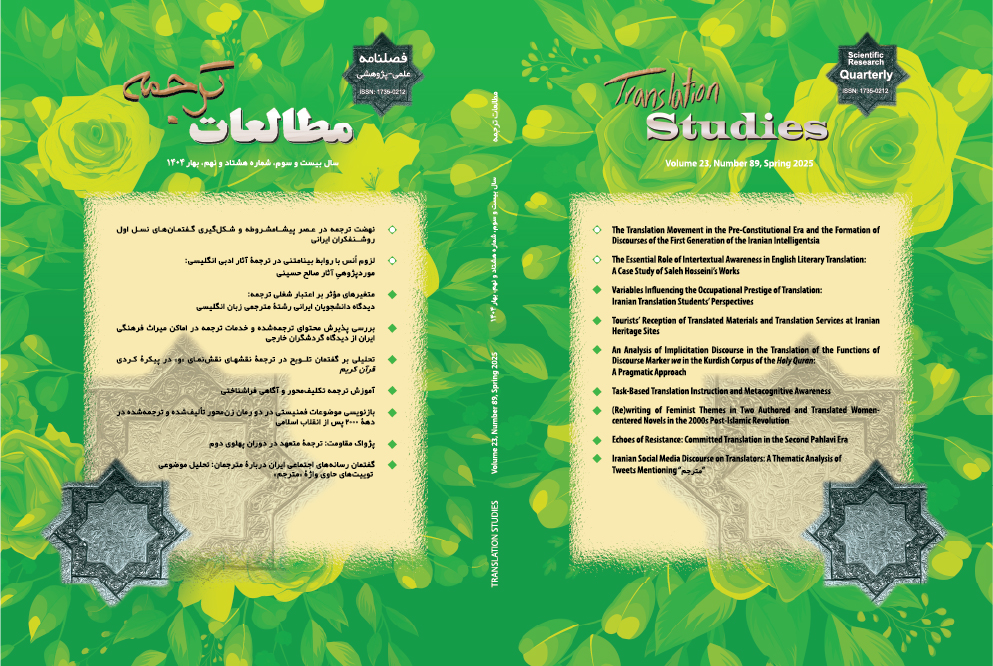گفتمان رسانه های اجتماعی ایران دربارۀ مترجمان
تحلیل موضوعی توییت های حاوی واژۀ «مترجم»
چکیده
در عصر رسانههای اجتماعی، انجام مطالعات دریافت آسانتر از گذشته شده است، چراکه افراد بهراحتی دیدگاههای خود را در فضای آنلاین بیان میکنند. بهاینترتیب، پژوهشگران میتوانند بدون تعامل مستقیم با کاربران، دادههای موجود را گردآوری و تحلیل کنند. توییتر (که اکنون با نام «ایکس» شناخته میشود)، منبعی غنی از محتوای تولیدشده توسط کاربران است؛ البته رعایت حریم خصوصی کاربران در این نوع تحقیقات ضرورت دارد. هدف این پژوهش بررسی دیدگاههای کاربران ایرانی ایکس درباره مترجمان و مضامین توییتهای فارسی حاوی واژه «مترجم» بود. این مطالعه کمک میکند تا دید بهتری نسبت به برداشتها و بازخوردهای مخاطبان نسبت به مترجمان و عملکرد آنها داشته باشیم. برای این منظور، تحلیل موضوعی بر روی پیکرهای از توییتهای کاربران در بازه زمانی ژوئن 2023 تا می 2024 انجام شده است. چارچوب نظری پژوهش، مدل «واکنش، پاسخ و عکسالعمل» چسترمن (2007) بوده است. یافتهها، هفت موضوع متمایز را در توییتهای فارسی نشان دادند. برجستهترین موضوع، «معرفی کتاب و مترجمان» و کمتکرارترین موضوع، «جستجوی مترجم و پیشنهادهای کاری» بود. این یافتهها نشان میدهند که ایکس شاید بستر مناسبی برای یافتن فرصتهای شغلی برای مترجمان نباشد؛ اما فضای ارزشمندی را برای معرفی کتابها و مترجمان برجسته و نیز بیان دیدگاهها در مورد عملکرد آنان (اعم از مثبت یا منفی) فراهم میکند.
مراجع
Ahmed, W., Bath, P. A., & Demartini, G. (2017). Chapter 4: Using Twitter as a Data Source: An Overview of Ethical, Legal, and Methodological Challenges. In K. Woodfield (Ed.), Advances in Research Ethics and Integrity (Vol. 2, pp. 79–107). Emerald Publishing Limited. https://doi.org/10.1108/S2398-601820180000002004
Attaran, A., & Farahzad, F. (2024). “I suggest you read my translation of this thread”: Twitter and paratextual interventions of the journalator. Iranian Journal of Translation Studies, 22(85). u
Bolouri, M., & Jalali, J. (2023). Translated fiction in Iran: Readers’ reception and expectations. Journal of Language Horizons, 7(3), 209–234. https://doi.org/10.22051/lghor.2023.40559.1695
Braun, V., & Clarke, V. (2006). Using thematic analysis in psychology. Qualitative Research in Psychology, 3(2), 77–101. https://doi.org/10.1191/1478088706qp063oa
Chesterman, A. (2007). Bridge concepts in translation sociology. In A. Fukari & M. Wolf (Eds.), Constructing a sociology of translation (pp. 171–183). John Benjamins.
Desjardins, R. (2017). Translation and Social Media: In Theory. In R. Desjardins, Translation and Social Media (pp. 35–66). Palgrave Macmillan UK. https://doi.org/10.1057/978-1-137-52255-9_3
Elimam, A. S. (2017). Translating the Qur’an into English: Target readers’ expectations. SKASE Journal of Translation and Interpretation, 11(1), 58–76.
Kermani, H., & Adham, M. (2021). Mapping Persian Twitter: Networks and mechanism of political communication in Iranian 2017 presidential election. Big Data & Society, 8(1), 1–16. https://doi.org/10.1177/20539517211025568
Khoshrouzadeh, J., & Salleh, H. M. (2016). Social media and TV: A preliminary review of interaction. New Media and Mass Communication, 48(1), 1–12.
Khoshsaligheh, M., Kafi, M., & Ameri, S. (2020). Fiction translation expectancy norms in Iran: A quantitative study of reception. The International Journal of Translation and Interpreting Research, 12(1), 74–89. https://doi.org/10.12807/ti.112201.2020.a05
Landers, C. E. (2001). Literary translation: A practical guide (Vol. 22). Multilingual Matters.
Luzón, M.-J. (2023). Multimodal practices of research groups in Twitter: An analysis of stance and engagement. English for Specific Purposes, 70, 17–32. https://doi.org/10.1016/j.esp.2022.10.006
Mollanazar, H. (2011). Text screening (censorship) in Iran: A historical perspective. Iranian Journal of Applied Language Studies, 3(2), 159–186.
Noushmand, N., & Miraki, M. (2024). Translators Agency in Persian Fansubbed Movies: A Paratextual Analysis. Critical Literary Studies, 6(2), 195–215. https://doi.org/10.22034/cls.2024.63088
Orrego-Carmona, D. (2016). A reception study on non-professional subtitling: Do audiences notice any difference? Across Languages and Cultures, 17(2), 163–181. https://doi.org/10.1556/084.2016.17.2.2
Purohit, H., Hampton, A., Shalin, V. L., Sheth, A. P., Flach, J., & Bhatt, S. (2013). What kind of# conversation is Twitter? Mining# psycholinguistic cues for emergency coordination. Computers in Human Behavior, 29(6), 2438–2447.
Salajegheh, S. (2024). Visibility of Iranian fansubbers of K-pop music videos. Translation and Interpreting Research, 1(1), 29–47. https://doi.org/DOI: 10.22054/r.2023.74726.1010
Steinert-Threlkeld, Z. C. (2018). Twitter as Data (1st ed.). Cambridge University Press. https://doi.org/10.1017/9781108529327
Willis, I. (2017). Reception (1st ed.). Routledge. https://doi.org/10.4324/9781315666587
Downloads
چاپشده
ارجاع به مقاله
شماره
نوع مقاله
DOR
مجوز
حق نشر 2025 Zahra Eidi Attarzadeh

این پروژه تحت مجوز بین المللی Creative Commons Attribution-NonCommercial 4.0 می باشد.
Copyright Licensee: Iranian Journal of Translation Studies. This article is an open access article distributed under the terms and conditions of the Creative Commons Attribution–NonCommercial 4.0 International (CC BY-NC 4.0 license).





